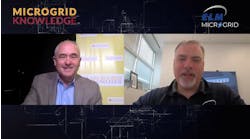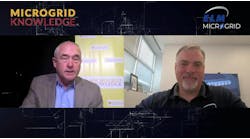Pacific Gas & Electric (PG&E) estimates that just over half a million electric vehicles (EV) plug into its grid today. That number will likely exceed 3 million by 2030, driven in part by the state’s pending ban on the sale of new gas-powered cars.
While the sharp uptick in EV adoption is expected to lead to a 70% increase in load demand, the utility sees significant potential in using EV batteries as a virtual power source to support the grid and energize mobile microgrids.
Give and take: bidirectional EV charging growing in popularity
With most of today’s EVs and EV charging technology, power flows in one direction – from the grid to the vehicle. There are some notable exceptions, including the Ford F-150 Lightning and the Nissan Leaf, both of which offer bidirectional charging, or the ability to send energy from the vehicle’s battery to other devices, such as a home or business.
As tales have spread across the internet of Ford’s electric pickup trucks providing folks with reliable power during a grid outage, consumer interest in and demand for bidirectional charging has increased, encouraging automakers and policymakers alike to react.
General Motors (GM) announced this year that bidirectional charging will be a standard feature on its electric vehicles by model year 2026. Tesla, which previously opted to forego bidirectional charging capabilities, recently reversed course and announced that the technology will be available on its vehicles by 2025.
And in July, California legislators proposed SB 233, a bill that would require all EVs to be equipped with bidirectional charging starting in model year 2030. The legislature will not take the bill up again until 2024.
Potentially millions of DERs
As EV adoption increases, the potential of essentially millions of grid-connected distributed energy resources (DERs) simply can’t be ignored by utilities.
“California is still in the early stages of an exciting energy transformation, and EVs are front and center as we reimagine the energy system for the future,” said Jason Glickman, executive vice president of engineering, planning and strategy for PG&E.
That’s why, according to Glickman, PG&E is working with BMW, Ford and GM to test bidirectional charging technologies that will enable EVs to help offset some of the load growth associated with electrification.
“We are collaborating with automakers and some of the world’s top innovators to test applications that will enable us to harness the power of EV batteries as a grid resource to support peak electricity demand periods and decarbonize the economy at the lowest societal cost,” Glickman said.
PG&E said that the EVs being charged on its grid today represent 6 GW of battery storage capacity – three times what it can generate at the Diablo Canyon Power Plant, a nuclear power plant in San Luis Obispo County, California.
But “at some point in the near future, we will have millions of EVs providing power back to the grid to help utilities like ours meet peak electricity demand without the need for nonrenewable energy resources,” said Glickman.
Bidirectional EVs can power mobile microgrids
In addition to exploring how the technologies can support the grid, PG&E is developing three pilot programs to test how bidirectional EVs and chargers can provide power to customers’ homes and businesses during an outage.
It’s also studying how the technology performs when used to power microgrids in high fire threat districts.
Historically, mobile microgrids, such as those deployed by the Footprint Project in Maui and in the wake of Hurricane Ida, have been powered by portable solar arrays or diesel generators.
Bidirectional EVs can be yet another mobile power source for microgrids – keeping critical services up and running when and where they’re needed most.
As part of its pilot program, PG&E is offering financial incentives for participating customers, including some which are paid upfront to those living in disadvantaged communities where affordability is often a barrier to EV, solar, storage and microgrid adoption.
“Bidirectional charging technology is available today that gives EV owners the ability to power their homes in the event of an outage or to offset energy use,” Glickman said. “The technology will also enable EVs to play a big role in offsetting some of the load growth associated with California’s path forward to electrification.”
Track news about microgrids. Subscribe to the free Microgrid Knowledge newsletter.








